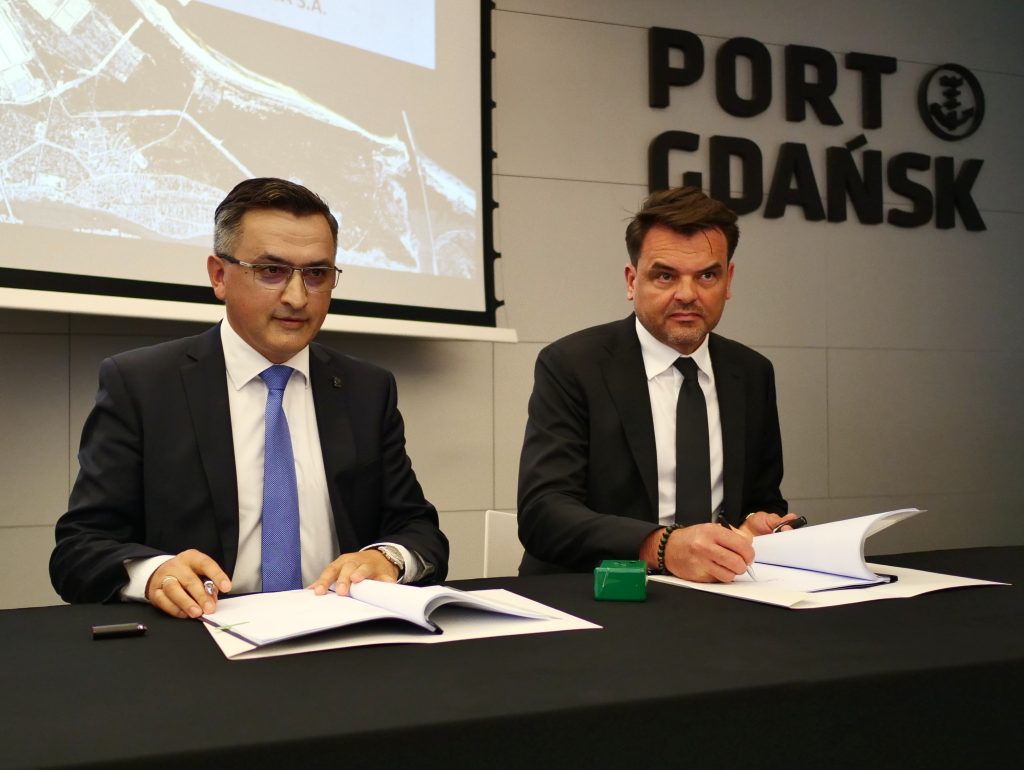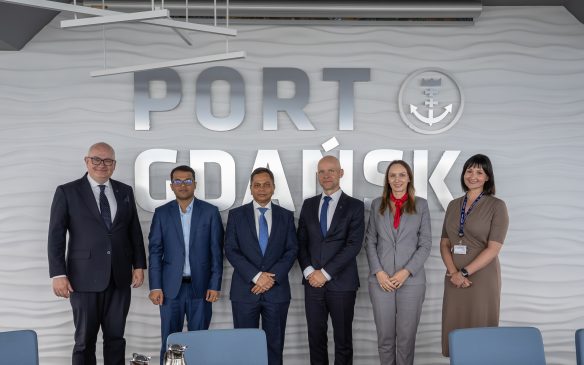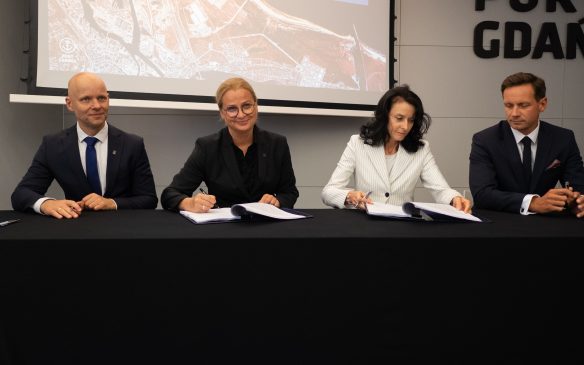Grain terminal in the Port of Gdańsk enters the implementation phase

Port Gdański Eksploatacja S.A. (PGE) from the Group of Companies of the Port of Gdańsk Authority signed an agreement with Premium Quality Care on 7 July 2025. The subject matter of the agreement was the construction of a large flat warehouse on Szczecińskie Quay as part of the first stage of construction of the Gdańsk Agro Terminal (GAT). The target is to have a modern grain terminal capable of handling around 3 million tonnes per year.
The agreement was signed on behalf of PGE by the President of the Management Board, Andrzej Kuźmicz, and on behalf of the contractor by Robert Skóra, President of the Management Board of Premium Quality Care.
Gdańsk Agro Terminal (GAT) is a strategic investment for the period from 2025 to 2028, responding to the demand of the agri-food market and the diversification of exports. As a result of a detailed analysis, an integrated project that assumes the following was developed:
- construction of one large flat warehouse on Szczecińskie Quay with an area of 7,000 m2 and a capacity of 30,000 tonnes (completion: 2025–2026),
- construction of a complex of flat-bottomed steel silos with a total capacity of 100,000 tonnes on Wiślane Quay (completion: 2026–2028;
- construction of a modern ship loading and unloading system with a capacity of 1,000 tonnes/hour;
- integration of the entire facility with the port’s railway, road and cargo handling infrastructure.
‘I am sure that both the renovation of the quay and the preparation of the entire road and rail infrastructure, as well as the construction of warehouses and the silos in subsequent stages, will allow for even greater cargo handling capacity at the Port of Gdańsk and will be crucial from the point of view of cargo handling in this part of the coast’, said Arkadiusz Marchewka, Deputy Minister of Infrastructure, who was present at the meeting.
Ultimately, the terminal will have a total of 160,000 tonnes of storage space and a cargo handling capacity of up to 3 million tonnes per year. This is more than four times its current capacity, which today amounts to 35,000 tonnes of storage capacity and 0.7 million tonnes of grain cargo handling per year.
‘The grain market is currently characterised by exceptional volatility – we are seeing significant fluctuations in volumes and export destinations, resulting from both the geopolitical situation and the pressure of climate change. We are designing the Gdańsk Agro Terminal with this volatility in mind – as a flexible, scalable infrastructure ready for various market scenarios. This investment shall not only increase our cargo handling capacity, but above all ensure the operational resilience of the Port of Gdańsk to fluctuations in supply and demand in the agri-food sector’, said Andrzej Kuźmicz, President of PGE. ‘What is equally important to GAT is a project financed 100% from national funds, aimed at ensuring long-term infrastructure security in Poland and efficient export services, regardless of their structure or scale in a given year.’
An environmentally friendly and market-oriented investment
The terminal, which is currently under construction, will use modern, automated technological systems that allow the efficient handling of bulk grains from hopper wagons, trucks and ships.
The flat warehouse to be built on Szczecińskie Quay, which is the first stage of the Gdańsk Agro Terminal, will be equipped with automated loading and unloading systems, including technological bridges, continuous transport equipment and systems limiting dust emissions. The infrastructure will be adapted to both rail and road transport, ensuring high operational flexibility. When starting the project, the focus was on ensuring maximum functionality of the structure already at the design and construction stage. This allows for full integration with the planned silo complex in the future, creating a coherent and effective cargo handling and storage system.
This is not only a qualitative leap in infrastructure construction, but also a real response to the environmental and social challenges. The project assumes the use of modern technological solutions that reduce dust, lower the risk of fires and protect the quality of stored grain. At the same time, the implementation of the new concept enables the effective management of various types of grain for a larger number of customers.
Schedule and financing
The Gdansk Agro Terminal will be built in two stages:
- Stage I (2025–2026) – construction of a flat warehouse on Szczecińskie Quay (currently under construction, gross value: PLN 13.8 million, financed from PGE’s own funds), signing of the agreement: 07/07/2025;
- Stage II (2026–2028) – construction of the silo complex and integration with the Wiślane Quay infrastructure.
The total cost of the GAT construction is PLN 240 million gross, of which the largest part is expenditure on technology (38%) and construction work (33%). The project will be financed from PGE’s own funds, following approval by the Supervisory Board and the General Meeting of Shareholders of the Port of Gdańsk and securing the financing of at least PLN 200 million. The procedure for selecting a contractor for the Feasibility Study for the second stage of the project, with an estimated cost of PLN 350,000 net, is currently underway.
‘The Gdańsk Agro Terminal is going to improve the competitiveness of the Port of Gdańsk by increasing its operational capabilities, logistics flexibility and loading efficiency. It is part of a long-term strategy to strengthen Poland’s position as a leader in grain exports’, says Dorota Pyć, President of the Port of Gdańsk. ‘The project is being developed at a strategic moment. In 2025 we shall begin the comprehensive redevelopment of Wiślane Quay, which is scheduled for completion in 2028, and creates a unique opportunity to integrate the new infrastructure with the modernised part of the Port of Gdańsk.



